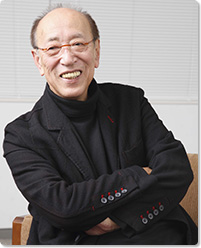Next Theater launched with noise-free young actors
- You became the artistic director of the Saitama Arts Theater in 2006. That year you started the Gold Theater project for amateur seniors, and this year you started the Next Theater project primarily for young actors. Was that your idea from the start when you became artistic director?
- I had the idea for Gold Theater but I didn’t have the idea for Next Theater at the time. I had been working with young people in my company, NINAGAWA STUDIO, but recently those activities had been missing. It might have been partly the frustration of that loss that inspired the new projects.
- The present NINAGAWA STUDIO began as the GEKI-SYA NINAGAWA STUDIO back in 1984. What are its activities like now?
- The STUDIO still exists. But the Benisan Pit building where we had rented our studio space was torn down because of its age and deterioration, so our studio space is gone. When we had a studio space we did our etude work there and created works that we then performed. Now, without that space we are unable to do that. The etude part is an essential part of our craft. So, I left the NINAGAWA STUDIO name as it was and told the people that I was starting Next Theater separately, and if anyone wanted to come for auditions, they could come there. For me, the STUDIO and Next Theater remain distinct, separate entities.
- For Gold Theater you have set an age limit of over 55. What is your policy concerning Next Theater? Do you run it as a production type company that holds auditions anew for each work to be performed?
- That hasn’t been decided specifically yet, but some specific system may be set eventually. I am also interested to see what these young people think about the organizational aspects. As we do productions for performance, there will be some people who are assigned parts and others who aren’t. If those people are still interested in being part of a group led by me, it will be possible to continue, and if that happens then we will have to think about adopting specific methods. At this stage, no one is being paid to participate yet, but if people, audiences find the performances interesting, we might possibly get funding support from the prefectural government. I believe it will take at least three years before people start considering that. (With a seniors company, there are no problems of the members having to earn a living) but if Next Theater becomes organized as a company, we will have to give the actors set salaries in order for it to continue operating.
- How many performances do you plan to do?
- I think we will do two or three productions a year, and if Gold Theater is included, that will make four a year, which will be quite a lot considering my present working schedule. At first, I will be directing, but eventually it would be good if I am able to pass that responsibility along smoothly to young, new directors.
- What standards do you use in choosing the young actors? I have heard that many of the people taking part in your recent audition were young people who have studied drama at various universities.
- Basically, the criteria I used for selecting them was whether they could speak their lines well, whether they can move naturally and the other things is whether they have what I call “lots of noise.” Wanted to find young people with untamed, animal-like instincts. But most of the actors you see are rather square. They have good posture. They have clear skin. Their speech is clean and proper. There is no interest in all of this. There is no noise, at all. It is important to be able to deliver your lines with clarity, but clarity without meaning is only annoying. There has to be something inside that possesses the actor and is brought out in words on stage, but there are few actors like that. What I am interested is having the actors speak to the audience with their acting, without any superfluous theatrics, but I don’t know yet how it will work out. It remains to be seen what we can do.
- Has the character of the actors changed?
-
Yes, it has changed. When I first began doing productions with NINAGAWA STUDIO, there were more actors with noise. Back then, that’s what Keizo Kanie and Renji Ishibashi were. They weren’t your proper actors. They stood out like sore thumbs, they did things that disturbed you, they disrupted my work (as director) [laughs]. They were many actors then who wanted to do something different from what others were doing. In contrast, most of the actors today are truly naïve, and too tranquil.
Re-evaluating Sanada Fuunroku as a Japanization of Brecht
- The play you chose for the first Next Theater production is Yoshiyuki Fukuda’s Sanada Fuunroku (Tale of the Sanada Family). This play is known as a revolutionary work of historically importance in contemporary Japanese theater that premiered in 1962 directed by Koreya Senda. With the Winter Battle (fuyunojin) and Summer Battle (natsunojin) of Osaka castle in which the Edo Bakufu forces overthrew the Toyotomi clan as the setting, this is an entertainment-oriented lay with songs that depicts the accomplishments and misfortunes of Yukimura Sanada and Juyushi Sanada, while at the same time being a political play that skillfully integrates the student protest movement and anti-US-Japan security pact confrontations that shook Japan at the time. What was the reason for choosing this particular play?
-
When the Japanese New Theater (Shingeki) movement tried to give Japanese body and flesh to Brecht-like Theater, Yoshiyuki Fukuda was the first to actually do that. Fukuda-san’s plays were the first one’s in which theater people at the time succeeded in creating a truly Japanese alienation effect in theater. In the ensuing Small Theater (Shogekijo) playwrights Juro Kara and Tadashi Suzuki went beyond Fukuda-san to a new realm all at once, but if it weren’t for Yoshiyuki Fukuda there would not have been the foundation from which they could have made their appearance like that. That is how important Fukuda-san’s work was and how significant it is historically.
Fukuda-san also wrote plays for the Budo-no-kai company that did “folklore theater” as well as realist theater works like Nagai Bohyo no Retsu (Long Rows of Gravestones), he re-evaluate theater, including popular theater and tried to write plays that included the perspective of the common people but also had an underlying alienation effect lie the plays of Brecht. The Brecht plays directed by people like Koreya Senda of Haiyu-za and Eitaro Ozawa were well done but they still had the scent of drama in translation somehow. Fukuda-san had digested all that and made theater that wasn’t embarrassing when performed with the Japanese physique and mannerisms.
Eventually Fukuda-san worked with the popular theater actor Ryuji Sawa, and I think it is because they wanted to create a type of theater that embraced also the pre-modern traditional Japanese that had been forgotten by modern Japanese theater. I wanted to do plays by Fukuda because I don’t think these aspects of his work have been fully appreciated or evaluated. If I gave the young people Sanada Fuunroku as a text and explained the issues involved in the acting of it, the fact that the performance would have to have both the realism drama aspect and the alienation drama aspect, you could covered the large part of contemporary drama, which inherently includes both elements. And I chose this text with the intention of teaching both of these drama elements. - Neither the historical events of the story’s setting or the demonstrations protesting the US-Japan security agreement that are superimposed on it in the play are things that today’s young people are familiar with.
- Personally, when I am working with the young people in directing this play, I don’t stress the significance of the political confrontation much. Because, if I bring the political confrontation to the forefront too much, there will be too many things that the young people don’t understand. However, it is a fact that the protestations of the students and the overall emergence of the new leftist movement in Japan is a central theme underlying this work, so I talk to them little by little about the worldwide student revolt that took place at that time.
- Fukuda-san also wrote several very good works besides Sanada Fuunroku in the 1950s and 60s.
-
I think
Hakamadare wa dokoda
(Where’s the Bandit) and
Nagai Bohyo no Retsu
(Long Rows of Gravestones) are good works. And, besides Fukuda-san, I was also very much impressed by
Kaeru shōten
(Ascension of the Frog) written by Junji Kinoshita in 1951. It takes an actual incident from the political trials at the end of the war involving a serious young man who commits suicide after being interrogated as a witness and transposes the story into a frog world. I was deeply impressed by that alarming dramatic world created in that play. I saw the premiere of that play at the Mitsukoshi Theater, where actor Yasue Yamamoto ran through the audience shouting “I hate war.” It shocked me. I had never imagined that theater could be like that. The fact that I often make use of the audience space in my directing today may come from that influence [laughs]. I had no idea theater could be that alive with raw emotions and feelings. It was inspiring in a very raw and fresh way.
I can’t say this for sure unless I read them again, but I think it can be good to perform the works of playwrights like Juro Miyoshi and Matsuyo Akimoto that were in the Shingeki (New Theater) genre but were never properly recognized by the Shingeki world because of their innovative nature. The people of the younger generation know well enough about pursuing the realities of their own world, but I also believe that gaining stage experience and knowledge about plays like this that are of a different existence will eventually be meaningful when it comes to making plays for and of their generation. - So, you take texts from these avant-garde Shingeki plays that influenced you and use them for the program of Next Theater now.
-
Yes. There is little meaning in having older people do this, but I think it is good to young people re-read these texts. I believe it is meaningful to have them read these texts as plays and also to read them properly as a stage in the development of our cultural history.
However, it is no easy task to get them to understand this. At this point, these works are distant enough that it is like doing a foreign play. They don’t know how to approach the text or the attitude to read them with, nor do they understand the customs of habits of the time that appear in them. It would be easier just to skip over all that and make a comic play. There is not single negative thing about learning to use the body to express things, so I want to tell them to do that. - This time you will be doing Sanada Fuunroku using only the stage area [without using the full hall] of the theater’s large hall. Why is this, when the theater also has a small hall?
-
The Saitama Arts Theater small hall is a little too large a space. I wanted to have them experience the close unity that is possible in a smaller space, and experience creating something using only the body. So we are creating a little theater on the stage itself as an educational experience for the actors.
Launching Gold Theater as a quest for reality based in the history of the people
- Next I would like to ask you about the Gold Theater project. What were the origins of your idea to work primarily with middle and senior age people with the aim of nurturing professional actors?
-
There is one fear, you might say, that I have had regarding my directing since early in my career. It is a fear of what the people of the older generation who don’t express their opinions and have lived normal lives would think if they saw my plays. Would my plays be meaningful in light of the personal histories they have lived? I have feared that if the elderly or people who don’t usually express their opinions saw our plays they might think, “The things made by these people who just went to school and studied are superficial, lacking in substance.” That is a very strong insecurity I have long had.
An example I sometimes use when explaining this is, “If the Komadori sisters (twin sisters who worked their up as singers through dire poverty and hardships in the hard early years of the postwar to become the stars of an era) suddenly came flying across our stage the whole play would freeze and come to stop.” I even thought seriously about how it would be to create a play where Hamlet is giving his “To be or not to be” lines and suddenly the Komadori sisters come out. If the Komadori sisters suddenly came out in the midst of one of our classic plays in translation and crossed the stage in their long-sleeved kimonos playing their shamisen, ben ben ben ben , our play would be blown away in an instant. In other words, I have thought that in the face of the actual “history of the common people” that has been live by the Japanese in the postwar era, exemplified by the Komadori sisters, our dramas, which are based on what we have earned from European drama, would probably be frozen over in an instant. It is because of this complex I have long held that I began the Gold Theater project, so I would be working with the very people of the elderly generation whose lives have that meaning for me, even if it is not exactly that of the Komadori sisters.
In fact, when considered relative the one extreme of the elderly (the common people), the plays I create as a director probably aren’t much at all. When I work with them it is not to create a theatrical sideshow with amateurs but with the hope that by working with these elderly for whom reality is of a different order—forgetfulness, difficulties in physical movement, inability to deliver lines smoothly—a different kind of reality from the theatrical type I normally to create will emerge in our the productions. I’m doing it in with real seriousness, because there is the possibility that it could shoot to the heart of the theater I have been doing until now. - In starting this project were you conscious of the activities of the avant-garde Polish thespian Tadeusz Kantor and the theater company for the elderly he leads, Cricot 2? They performed The Dead Class in Japan in 1982. Did you see that performance?
- Yes, I saw it. It was quite a shock for me, so the image remained in my mind. I remember thinking at the time, “So this is what they do as avant-garde in Europe” and I didn’t think of it as immature as theater. It was not a manipulation of things purely on the conceptual level but opened up the possibility of looking at the human being relatively from a different angle; for example in The Dead Class the old people talk about their life when they were children and students in school. I was deeply impressed by the intellectual depth of it all. The idea is can we do something in a different form from Kantor. One variation might only take it close to Shuji Terayama.
- It has been three years since you launched the Gold Theater program in 2006. How much of the things you had in mind are actually being achieved?
-
For example, there is an elderly member named Mr. Toyama, and watching him perform I see qualities that no ordinary professional actor can match. In his voice, his gestures, the way he speaks and his timing (effective pause) he has a completely different quality of acting that no professional actor could begin to approach. Seeing that has made me realize the value of this program.
The people of Gold Theater deal with a certain condition that is age and aging. Their memories are inconsistent. It is difficult for them to memorize new things. Something they were able to do yesterday they may not necessarily be able to do again today. And, sometimes they will be able to do something today that they were unable to do yesterday. This means that we have to create our plays in a way that embraces all the qualities of the lives of the aged. You can’t take a certain portion of it to focus on, you have to deal with it all, you have to compose things so that if someone forgets a line, it will be alright. In that context, the director can’t afford to sit in his usually place out in the audience seats. He (I) has to be there on stage to fill in those gaps when they occur. In other words, it can’t be a process where we are working toward artistic completion but rather we must show the entirety as theater, including all of these aspects of age.
We take the attitude that the things that come with age, the forgetting, the sudden recollections, the inconsistence in forms of expression, will all happen on stage during the play, and we make all manner of measures so that the play will still go on successfully when and if these things happen. I accept all of the things that have happened in the 74 years of (my) life and I prepare a play to go on stage before an audience. If that concession is not made, that play cannot be called theater. That defines a realm of drama in which, yes, this can also be called theater, or by seeing the play can bring new discoveries in one’s life, as I think our recent play (My Night at Ando’s by Keralino Sandorovich) did. - There do appear to be parts that are better than if it were done by elderly professional actors, aren’t there? We find ourselves being attracted to the way a particular person’s life and presence come out naturally on stage.
- There definitely is something in that, isn’t there? One of our members how was in a Kamikaze squadron when the war ended and made it back alive even says he gets more frightened and nervous on stage than he ever did during the war! [laughs]. Working with people like this who have experienced more in their lives than me and seeing how hard they try on stage, with a different level of intensity, is a true enjoyment. Also, the members seem to get younger through their involvement in these plays. If for no other reason than purely how interesting the stage is. The enjoyment of seeing what they can create and bring to the audience brings them alive, and seeing this I feel once again that indeed you can call this theater.
- It appears that your becoming artistic director of the public theater facility Saitama Arts Theater has laid the foundation that makes the Gold Theater and Next Theater programs possible. This is something that is not easily achieved in the public sector.
-
Yes. Since it is a public institution, in theory we have to give substantial information, including statistics, proving how these groups are contributing to the community, but in this area Saitama Prefecture has given me a considerable amount of leeway to deal with these questions as we go along, and this is also possible because it is a public-sector theater. And as we continue to bring results and the audience supports the activities of these people and asks the prefecture for more support, we may eventually get more funding as necessary.
For a public-sector theater it is better if it is not decided from the beginning what the budget is, what the specific requests are and what the salaries will be. The best relationship is if there are people in charge at the prefectural and facility levels who will look honestly at the specific contents of the activities and decide on an appropriate level of support given those activities. I personally would like to see a situation in which we show that we are not wasting any money and putting our full efforts into this work and continuing to provide products that satisfy the audiences and, seeing that, the prefectural side will evaluate honestly that amount of funding and other forms of support we should be getting.
Saitama Next Theater
The founding of this project was inspired by the meeting with many young actors in the 2008 production of Between 95kg and 97kg . Recently, open auditions were held to select the cast for Sanada Fuunroku (Tale of the Sanada Family) from among more than 1,200 applicants, with 27 men and 17 women being selected (total: 44). The project will continue to mount productions of new works with the aim of nurturing young actors.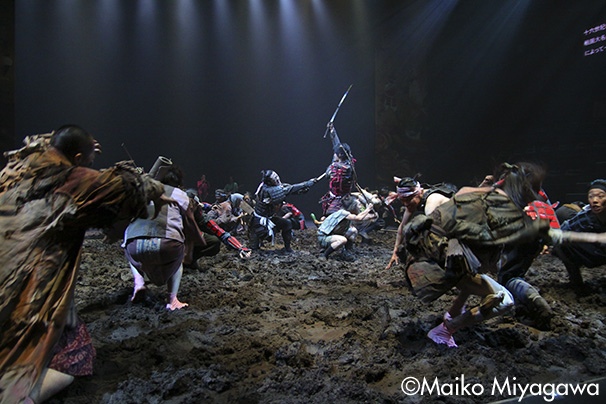
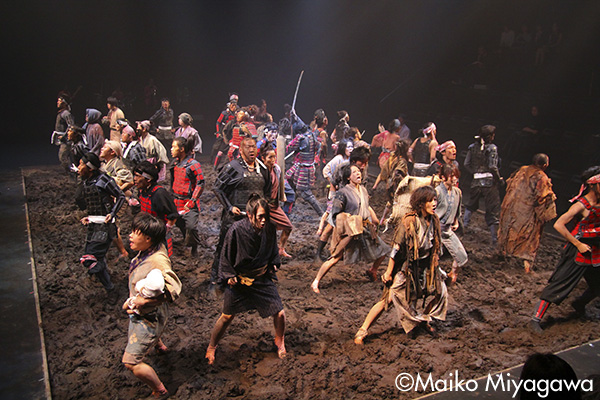
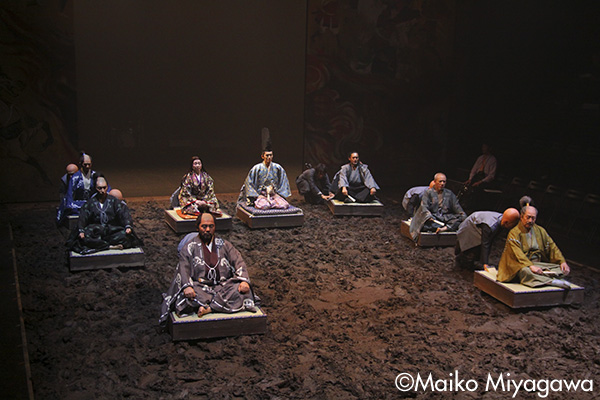
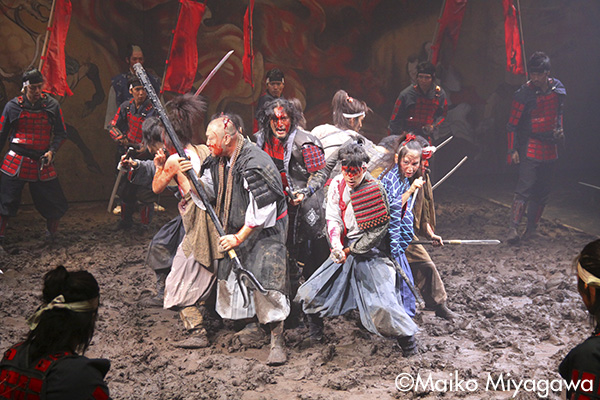
Saitama Next Theater
Sanada Fuunroku
(Oct. 15 – Nov. 1, 2009 at Saitama Arts Theater – Inside Theater)
Written by Yoshiyuki Fukuda
Photo: Maiko Miyagawa
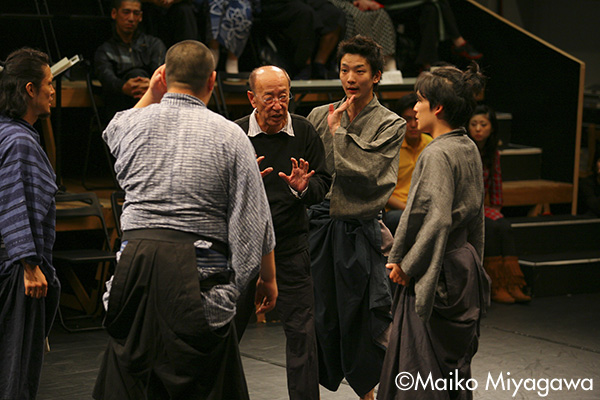
Sanada Fuunroku (rehearsal)
Photo: Maiko Miyagawa
Saitama Gold Theater
Founded in 2006 out of Ninagawa’s desire to search for a new form of theater based in the personal histories of the people of age, this theater project for people over 55 years of age seeks to nurture professional actors. Ninagawa personally spent two weeks auditioning people of over 55 years of age from among 1,200 applicants and selected 48 final members between the ages of 55 and 80. All the members gather four hours a day, five days a week for basic training and acting instruction by Ninagawa and his staff. The activities are characterized by etude sessions using the texts of plays by Kunio Shimizu, a playwright who led the angura (underground) theater and political theater movements of the day, working with Ninagawa from 1969 to ’74 (important works in the history of modern Japanese theater) and other classic drama like Chekov. Performances in 2006 included the interim performance called “Pro-cess” in July (anthology) and in December (Kunio Shimizu’s Karasu yo, Oretachi wa Dangan o komeru ). In 2007, the company preformed its first official production with the work Senjo no Picnic (Picnic on the Boat) written for this production by Ryo Iwamatsu . In 2008 the company performed two old works by Kunio Shimizu, Omoide no Nihon ichimannen for the Pro-cess program and Between 95kg and 97kg for the company’s second official production. Between 95kg and 97kg is a work written for the second official production of the company GEKI-SYA NINAGAWA STUDIO (present NINAGAWA STUDIO) founded by Ninagawa with young actors in 1984. In 2009, the company performed My Night at Ando’s written specially for this production by Keralino Sandorovich . In the future, plans call for Saitama Gold Theater to present new plays written by newly commissioned playwrights at a pace of one a year. Presently the company has 42 members.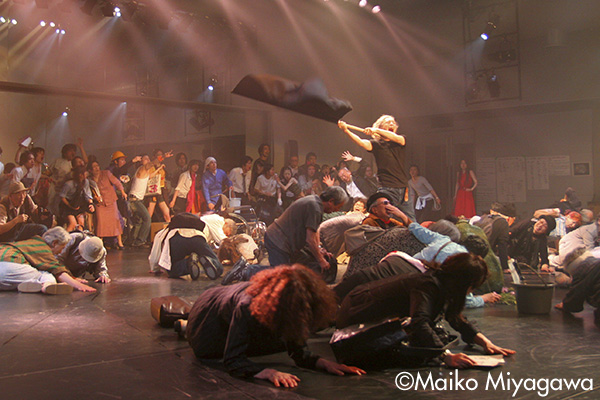
Saitama Gold Theater 2rd performance
Between 95kg and 97kg
(May. 28 – Jun. 5, 2008 at Saitama Arts Theater – Large rehearsal room)
Written by Kunio Shimizu
Directed by Yukio Ninagawa
Photo: Maiko Miyagawa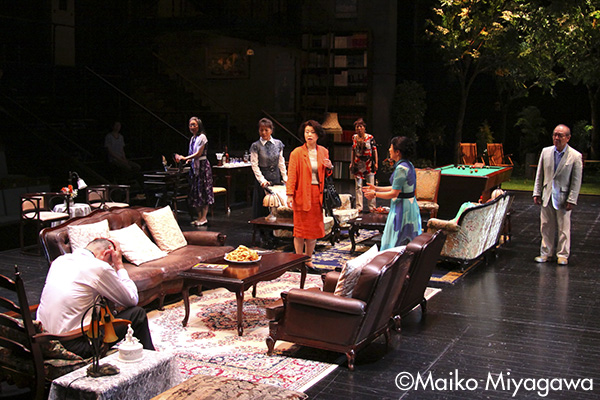
Saitama Gold Theater 3rd performance
My Night at Ando’s
(Jun. 18 – Jul. 1, 2009 at Saitama Arts Theater – Small theater)
Written by Keralino Sandrovich
Directed by Yukio Ninagawa
Photo: Maiko Miyagawa


